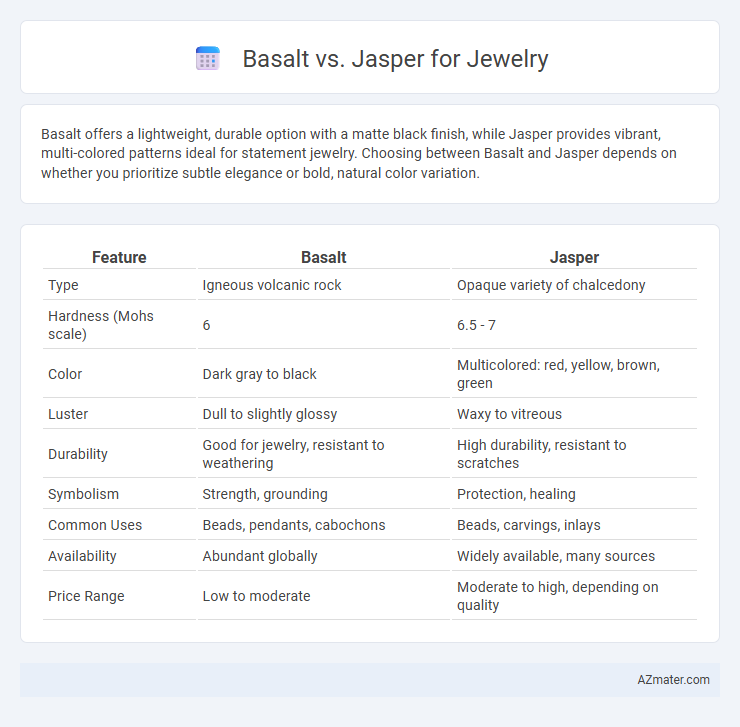Basalt offers a lightweight, durable option with a matte black finish, while Jasper provides vibrant, multi-colored patterns ideal for statement jewelry. Choosing between Basalt and Jasper depends on whether you prioritize subtle elegance or bold, natural color variation.
Table of Comparison
| Feature | Basalt | Jasper |
|---|---|---|
| Type | Igneous volcanic rock | Opaque variety of chalcedony |
| Hardness (Mohs scale) | 6 | 6.5 - 7 |
| Color | Dark gray to black | Multicolored: red, yellow, brown, green |
| Luster | Dull to slightly glossy | Waxy to vitreous |
| Durability | Good for jewelry, resistant to weathering | High durability, resistant to scratches |
| Symbolism | Strength, grounding | Protection, healing |
| Common Uses | Beads, pendants, cabochons | Beads, carvings, inlays |
| Availability | Abundant globally | Widely available, many sources |
| Price Range | Low to moderate | Moderate to high, depending on quality |
Introduction to Basalt and Jasper in Jewelry
Basalt, a volcanic igneous rock, is valued in jewelry for its durability and unique matte texture, often crafted into beads and cabochons that provide a natural, earthy aesthetic. Jasper, a variety of chalcedony, is prized for its rich color patterns and smooth finish, making it a popular choice for decorative inlays and statement pieces. Both stones offer distinct visual appeal and robustness, catering to different design preferences in jewelry making.
Origins and Geological Formation
Basalt, an igneous rock formed from rapid cooling of lava rich in magnesium and iron, originates primarily from volcanic regions such as the Hawaiian Islands and Iceland. Jasper, a variety of chalcedony composed mainly of silica, forms through sedimentary processes involving the accumulation and compression of fine-grained quartz and iron oxides, commonly found in regions like India, Russia, and Madagascar. Understanding their distinct geological formation highlights basalt's volcanic origin and jasper's sedimentary nature, influencing their unique textures and colors prized in jewelry making.
Physical Properties: Hardness and Durability
Basalt, with a Mohs hardness of around 6, offers moderate durability suitable for casual jewelry but is prone to wear and scratches over time. Jasper ranks higher on the Mohs scale, typically between 6.5 and 7, providing greater hardness and resistance to chipping, making it ideal for long-lasting, everyday jewelry pieces. The dense, fine-grained structure of basalt contrasts with jasper's more robust composition, enhancing jasper's appeal for durable jewelry applications.
Color Variations and Aesthetic Appeal
Basalt offers a deep, rich black or dark gray color with a matte to slightly rough texture, creating a bold, earthy aesthetic ideal for minimalist or rustic jewelry designs. Jasper boasts a wide array of color variations including reds, yellows, browns, greens, and blues, often with intricate patterns and banding that enhance its vibrant, eye-catching appeal. The choice between basalt and jasper in jewelry hinges on the desired visual impact, with basalt providing subtle elegance and jasper delivering dynamic, colorful vibrancy.
Popular Jewelry Uses: Basalt vs Jasper
Basalt, known for its rich, dark color and volcanic origins, is popular in jewelry for its durability and sleek, modern aesthetic, often crafted into beads, cabochons, and statement rings. Jasper, prized for its wide range of earthy tones and unique patterns, is frequently used in pendants, bracelets, and earrings, providing a warm, natural look favored in bohemian and artisanal jewelry styles. Both stones offer distinct visual appeal and structural properties, making basalt ideal for contemporary designs and jasper a staple in more traditional or rustic jewelry collections.
Workability and Craftsmanship Considerations
Basalt offers excellent workability due to its fine-grained texture, allowing artisans to achieve smooth finishes and intricate shapes with relative ease. Jasper's hardness and dense composition require specialized tools and more time-intensive craftsmanship, resulting in highly durable jewelry pieces with detailed patterns. Choosing between basalt and jasper depends on the desired balance between ease of carving and the final piece's longevity and visual complexity.
Care and Maintenance for Each Stone
Basalt jewelry requires gentle cleaning with warm, soapy water and a soft cloth to maintain its matte finish and prevent surface damage caused by abrasive materials. Jasper's durability allows for more robust care, but it should still be cleaned with mild detergent and a soft brush to avoid scratches and preserve its polished surface. Avoid exposing both stones to harsh chemicals, extreme temperatures, or prolonged sunlight to prevent color fading and structural weakening over time.
Price Comparison and Market Value
Basalt jewelry is generally more affordable due to its abundant availability and lower demand, making it an economical choice for casual or contemporary pieces. Jasper, valued for its rich colors and unique patterns, commands higher prices and stronger market demand, especially among collectors and fine jewelry designers. Market value for Jasper consistently exceeds Basalt, reflecting its perceived rarity and aesthetic appeal in the gemstone industry.
Symbolism and Cultural Significance
Basalt, formed from volcanic lava, symbolizes strength and resilience, often linked to grounding energy and protection in various cultures, especially among indigenous peoples. Jasper, known as the "supreme nurturer," carries deep cultural significance, representing healing, stability, and balance across ancient civilizations like the Egyptians and Native Americans. Both stones hold rich symbolic value in jewelry, with basalt emphasizing endurance and jasper embodying emotional harmony and spiritual well-being.
Choosing the Right Stone for Your Jewelry
Basalt offers a rugged, volcanic appeal with its dark, fine-grained texture, ideal for bold and earthy jewelry designs, while Jasper provides a wide range of colors and patterns, making it versatile for personalized and intricate pieces. Consider durability, as Jasper rates 6.5-7 on the Mohs scale, offering moderate hardness, whereas Basalt, being more porous and softer, may require careful handling in daily wear. Choose Jasper for vibrant, polished aesthetics and variety, and Basalt for natural, matte finishes that emphasize organic, unique textures in your jewelry collection.

Infographic: Basalt vs Jasper for Jewelry
 azmater.com
azmater.com